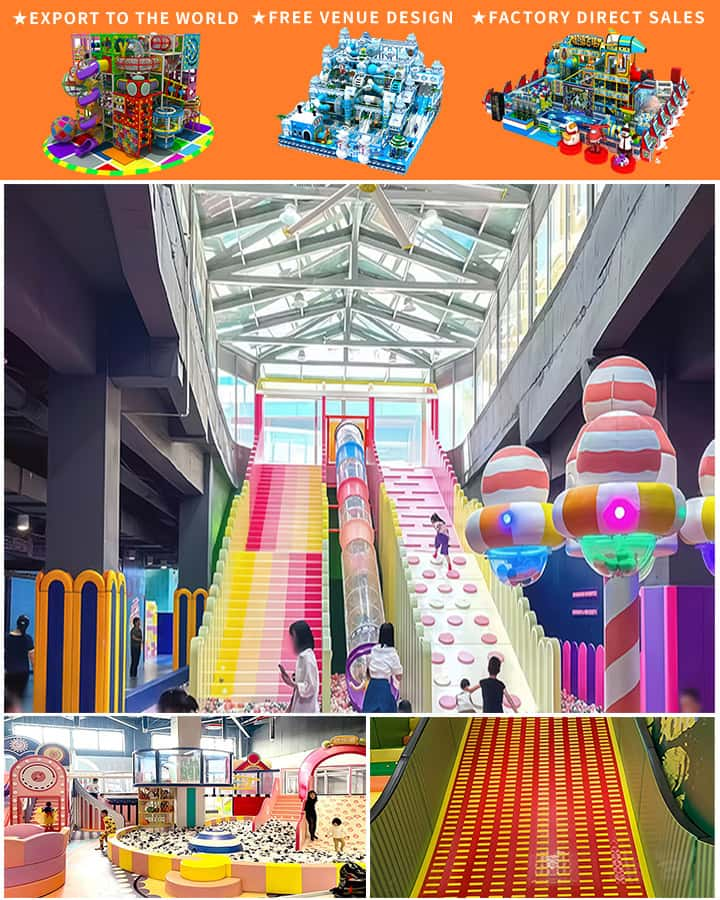Creating a stimulating indoor playground is a fantastic way to provide children with a safe and engaging environment for play, learning, and development. Indoor playground equipment not only offers an excellent outlet for physical activity but also supports cognitive and social development. This ultimate guide will explore various types of indoor playground equipment, their benefits, and how to design the perfect indoor play space for children of all ages.
Types of Indoor Playground Equipment
- Slides:
- Description: Available in numerous shapes, sizes, and themes, indoor slides are a classic component of any playground setup.
- Benefits: Enhances motor skills, promotes balance, and provides exhilarating fun.
- Climbing Walls:
- Description: Designed to mimic real rock climbing challenges, these walls come with varying levels of difficulty.
- Benefits: Strengthens muscles, improves coordination, enhances problem-solving skills, and boosts self-confidence.
- Trampolines:
- Description: Indoor trampolines offer a safe, enclosed space for jumping and bouncing.
- Benefits: Increases cardiovascular fitness, strengthens leg muscles, and improves balance and coordination.
- Ball Pools:
- Description: Large pools filled with plastic balls, often accompanied by inflatable structures or obstacle courses.
- Benefits: Encourages physical activity, stimulates sensory exploration, and fosters creativity and imagination.
- Play Structures:

- Description: Comprising tunnels, bridges, platforms, and ladders, these structures offer diverse climbing and traversing challenges.
- Benefits: Develops gross motor skills, spatial awareness, and encourages cooperative play among children.
- Interactive Panels:
- Description: Equipped with games, buttons, and lights, these panels engage children with interactive play.
- Benefits: Stimulates cognitive development, hand-eye coordination, and fine motor skills.
- Soft Play Areas:
- Description: Made from soft foam materials, these areas are designed to prevent injuries during play.
- Benefits: Ensures safety, allows for free movement, and helps develop physical confidence in younger children.
Benefits of Indoor Playground Equipment
- Physical Development:
- Regular use of playground equipment promotes physical fitness, muscle development, and coordination. It provides a constructive outlet for children’s energy, ensuring they stay active even on rainy days or during colder months.
- Cognitive Skills:
- Interactive elements like climbing walls and puzzle panels stimulate cognitive functions such as problem-solving, decision-making, and spatial reasoning.
- Social Interaction:
- Group activities facilitated by playground equipment encourage social interaction, teamwork, and communication skills. Children learn to share, negotiate, and build relationships through cooperative play.
- Emotional Well-being:
- A well-designed playground can be a source of joy and excitement, helping to reduce stress and anxiety. The sense of accomplishment gained from mastering new skills boosts self-esteem and emotional resilience.
Designing the Perfect Indoor Play Space
- Safety First:
- Ensure that all equipment meets safety standards with proper padding, rounded edges, and sturdy construction. Regular maintenance and checks are crucial to prevent accidents.
- Age Appropriateness:
- Tailor the equipment selection to suit different age groups, ensuring that challenges are appropriate for the children’s capabilities and interests.
- Diverse Activities:
- Incorporate a mix of physical, cognitive, and sensory activities to cater to varied interests and developmental stages. This ensures that all children find something enjoyable and beneficial.
- Accessibility:
- Design the playground to be inclusive, providing access for children with disabilities. Features like wheelchair ramps and adaptive equipment ensure everyone can participate.
- Aesthetic Appeal:
- Use bright colors, themed designs, and creative layouts to make the indoor playground visually inviting. An aesthetically pleasing environment can enhance the overall experience and engagement.
Conclusion
Indoor playground equipment is more than just a fun pastime; it is a vital tool for promoting physical health, cognitive growth, and social skills in children. By carefully selecting equipment and thoughtfully designing the play space, parents, educators, and caregivers can create an enriching environment that supports the multifaceted development of children. Whether you’re setting up a playroom at home or designing a commercial indoor playground, investing in high-quality, diverse equipment will provide endless opportunities for fun and learning.




